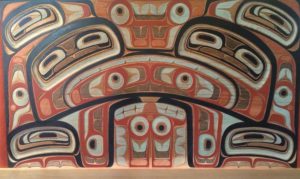 Jaalen and his brother Gwaai have been researching ancestral bentwood box design since they began tracing artworks under the guidance of their father Guujaaw. Bentwood boxes were used by the Haida for all kinds of purposes from cooking to treasure boxes that hold regalia. As treasure boxes, they were markers of high status and the designs on the sides were often based around Kuna Ka T’aa, the Wealth Bringer and Whale Eater.
Jaalen and his brother Gwaai have been researching ancestral bentwood box design since they began tracing artworks under the guidance of their father Guujaaw. Bentwood boxes were used by the Haida for all kinds of purposes from cooking to treasure boxes that hold regalia. As treasure boxes, they were markers of high status and the designs on the sides were often based around Kuna Ka T’aa, the Wealth Bringer and Whale Eater.
The Great Box in the Pitt Rivers Museum Collection is just such a treasure chest. It appeared in the Pitt Rivers collection in 1884 and has been a stunning highlight ever since. Jaalen and Gwaai first saw it when they visited the PRM as part of a Haida delegation to the museum in 2009. Astounded by the box’s designs, clearly executed by a master artist, the pair sought the opportunity to study it in depth. In 2014, with support from the PRM, the University of Oxford, the Arts Council England, the Canada Council for the Arts and the BC Arts Council, Jaalen and Gwaai spent a month in one of the museum galleries creating a new response box alongside the Nineteenth century original. The artists had bent the new blank box out of a long old growth cedar plank in Masset and then shipped it to the PRM. Day after day in the gallery they carved the most complex face of the box, taking all the time they could get to study the ancestral piece with precision.
 Now complete, the response box, entitled The Great Box Considered, is back in Canada, mostly residing in Haida Gwaii when it’s not on tour in exhibits like Haida Now at the Museum of Vancouver. Having completed this first box study, both Jaalen and Gwaai were keen to continue their journey by tracking down additional boxes in museum collections elsewhere by the same master artist. Having created a collection of unique conventions and innovations the nineteenth century artist used, they examined museum catalogues in search of possible candidate boxes and works. This journey has taken them to the American Museum of Natural History in New York, the Field Museum in Chicago, the Royal BC Museum in Victoria, and the Burke Museum in Seattle.
Now complete, the response box, entitled The Great Box Considered, is back in Canada, mostly residing in Haida Gwaii when it’s not on tour in exhibits like Haida Now at the Museum of Vancouver. Having completed this first box study, both Jaalen and Gwaai were keen to continue their journey by tracking down additional boxes in museum collections elsewhere by the same master artist. Having created a collection of unique conventions and innovations the nineteenth century artist used, they examined museum catalogues in search of possible candidate boxes and works. This journey has taken them to the American Museum of Natural History in New York, the Field Museum in Chicago, the Royal BC Museum in Victoria, and the Burke Museum in Seattle.
A key stop on their trip was the Field Museum in Chicago where they had discovered another box they believe is by the same ancestral artist. In Chicago, they did an extensive study and documentation of the box and it sparked another new piece by Jaalen entitled the Gidansda Settee. Read more about this chief’s chair used at Guujaaw’s potlatch in 2017 here.
